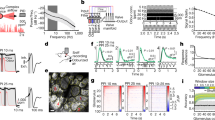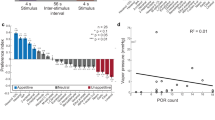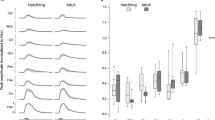Abstract
The neural computations used to represent olfactory information in the brain have long been investigated1,2,3. Recent studies in the insect antennal lobe suggest that precise temporal and/or spatial patterns of activity underlie the recognition and discrimination of different odours3,4,5,6,7, and that these patterns may be strengthened by associative learning8,9. It remains unknown, however, whether these activity patterns persist when odour intensity varies rapidly and unpredictably, as often occurs in nature10,11. Here we show that with naturally intermittent odour stimulation, spike patterns recorded from moth antennal-lobe output neurons varied predictably with the fine-scale temporal dynamics and intensity of the odour. These data support the hypothesis that olfactory circuits compensate for contextual variations in the stimulus pattern with high temporal precision. The timing of output neuron activity is constantly modulated to reflect ongoing changes in stimulus intensity and dynamics that occur on a millisecond timescale.
This is a preview of subscription content, access via your institution
Access options
Subscribe to this journal
Receive 51 print issues and online access
$199.00 per year
only $3.90 per issue
Buy this article
- Purchase on Springer Link
- Instant access to full article PDF
Prices may be subject to local taxes which are calculated during checkout




Similar content being viewed by others
References
Adrian, E. D. Olfactory reactions in the brain of the hedgehog. J. Physiol. 100, 459–473 (1942).
Gelperin, A. & Tank, D. W. Odour-modulated collective network oscillations of olfactory interneurons in a terrestrial mollusc. Nature 345, 437–440 (1990).
Laurent, G., Wehr, M. & Davidowitz, H. Temporal representations of odors in an olfactory network. J. Neurosci. 16, 3837–3847 (1996).
Laurent, G. & Davidowitz, H. Encoding of olfactory information with oscillating neural assemblies. Science 265, 1872–1875 (1994).
Wehr, M. & Laurent, G. Odour encoding by temporal sequences of firing in oscillating neural assemblies. Nature 384, 162–166 (1996).
Joerges, J., Küttner, A., Galizia, G. & Menzel, R. Representations of odours and odour mixtures visualized in the honeybee brain. Nature 387, 285–288 (1997).
Heinbockel, T., Kloppenburg, P. & Hildebrand, J. G. Pheromone-evoked potentials and oscillations in the antennal lobes of the sphinx moth Manduca sexta. J. Comp. Physiol. A 182, 703–714 (1998).
Faber, T., Joerges, J. & Menzel, R. Associative learning modifies neural representations of odours in the insect brain. Nature Neurosci. 2, 74–78 (1999).
Stopfer, M. & Laurent, G. Short-term memory in olfactory network dynamics. Nature 402, 664–668 (1999).
Murlis, J. in Insect Pheromone Research: New Directions (eds Cardé, R. T. & Minks, A. K.) 221–231 (Chapman & Hall, New York, 1997).
Christensen, T. A., Heinbockel, T. & Hildebrand, J. G. Olfactory information processing in the brain: encoding chemical and temporal features of odors. J. Neurobiol. 30, 82–91 (1996).
Hildebrand, J. G. Olfactory control of behavior in moths: central processing of odor information and the functional significance of olfactory glomeruli. J. Comp. Physiol. A 178, 5–19 (1996).
Hansson, B. S. & Christensen, T. A. in Insect Olfaction (ed. Hansson, B. S.) 125–161 (Springer, Berlin, 1999).
Christensen, T. A. & White, J. E. in The Neurobiology of Taste and Smell Vol. 2 (eds Finger, T. E., Silver, W. L. & Restrepo, D.) 201–232 (Wiley, New York, 2001).
Vickers, N. J. & Baker, T. C. Reiterative responses to single strands of odor promote sustained upwind flight and odor source location by moths. Proc. Natl Acad. Sci. USA 91, 5756–5760 (1994).
Vickers, N. J., Christensen, T. A. & Hildebrand, J. G. Combinatorial odor discrimination in the brain: attractive and antagonist odor blends are represented in distinct combinations of uniquely identifiable glomeruli. J. Comp. Neurol. 400, 35–56 (1998).
Christensen, T. A., Pawlowski, V. M., Lei, H. & Hildebrand, J. G. Multi-unit recordings reveal context-dependent modulation of synchrony in odor-specific neural ensembles. Nature Neurosci. 3, 927–931 (2000).
Lei, H., Christensen, T. A. & Hildebrand, J. G. Odor-evoked synchronization of olfactory networks: comparison of output neurons innervating the same and different glomeruli in the antennal lobe of Manduca sexta. Soc. Neurosci. Abstr. 26, 1208 (2000).
Baker, T. C. & Vickers, N. J. in Insect Pheromone Research: New Directions (eds Cardé, R. T. & Minks, A. K.) 248–264 (Chapman & Hall, New York, 1997).
King, J. R., Christensen, T. A. & Hildebrand, J. G. Response characteristics of an identified, sexually dimorphic olfactory glomerulus. J. Neurosci. 20, 2391–2399 (2000).
Buračas, G. T. & Albright, T. D. Gauging sensory representations in the brain. Trends Neurosci. 22, 303–309 (1999).
Christensen, T. A., Waldrop, B. R. & Hildebrand, J. G. Multitasking in the olfactory system: context dependent responses to odors reveal dual GABA-regulated coding mechanisms in single olfactory projection neurons. J. Neurosci. 18, 5999–6008 (1998).
Christensen, T. A., Mustaparta, H. & Hildebrand, J. G. Chemical communication in heliothine moths. VI. Parallel pathways for information processing in the macroglomerular complex of the male tobacco budworm moth Heliothis virescens. J. Comp. Physiol. A 177, 545–557 (1995).
Acknowledgements
We thank S. Hannaford and M. Willis for help in constructing the small wind tunnel. This work was supported by United States Department of Agriculture (National Research Initiative), National Institutes of Health (National Institute for Deafness and Other Communication Disorders), and Defense Advanced Research Projects Agency (Controlled Biological Systems).
Author information
Authors and Affiliations
Corresponding author
Supplementary information
Rights and permissions
About this article
Cite this article
Vickers, N., Christensen, T., Baker, T. et al. Odour-plume dynamics influence the brain's olfactory code. Nature 410, 466–470 (2001). https://doi.org/10.1038/35068559
Received:
Accepted:
Issue Date:
DOI: https://doi.org/10.1038/35068559
This article is cited by
-
The PROUST hypothesis: the embodiment of olfactory cognition
Animal Cognition (2023)
-
Spatial information from the odour environment in mammalian olfaction
Cell and Tissue Research (2021)
-
Is Anopheles gambiae attraction to floral and human skin-based odours and their combination modulated by previous blood meal experience?
Malaria Journal (2020)
-
Nanostructured cantilever sensor using with Pani/MWCNT-COOH nanocomposites applied in the detection of pheromone
Journal of Materials Science: Materials in Electronics (2020)
-
Stimulus- and goal-oriented frameworks for understanding natural vision
Nature Neuroscience (2019)
Comments
By submitting a comment you agree to abide by our Terms and Community Guidelines. If you find something abusive or that does not comply with our terms or guidelines please flag it as inappropriate.



